Collection Characteristic of Nanoparticles Emitted from a Diesel Engine with Residual Fuel Oil and Light Fuel Oil in an Electrostatic Precipitator
Abstract
1. Introduction
2. Experimental Setup
3. Results and Discussion
3.1. Influence of Fuel Oil on Distribution
3.2. Influence of Polarity on Distribution
3.3. Collection Efficiency
4. Conclusions
- (1)
- The peak concentration, at 76 nm of size distribution in the exhaust gas from residual fuel oil, decreased with an in increase in the applied voltage. However, the nanoparticle concentration at a size of 20 nm increased. On the other hand, the nanoparticle concentration did not increase in the exhaust gas when light fuel oil was used. These results indicate that the increased nanoparticle concentration in the exhaust gas, using residual fuel oil, may be due to ion-induced and binary homogeneous nucleation.
- (2)
- The amount of nanoparticle increase due to corona discharge in negative polarity was greater than that in positive polarity at the same voltage.
- (3)
- An optimum voltage, used to suppress nanoparticle concentration, exists for the collection efficiency.
Author Contributions
Funding
Conflicts of Interest
References
- Zukeran, A.; Ikeda, Y.; Ehara, Y.; Matsuyama, M.; Ito, T.; Takahashi, T.; Kawakami, H.; Takamatsu, T. Two-Stage Type Electrostatic Precipitator Re-entrainment Phenomena under Diesel Flue Gases. IEEE Trans. Ind. Appl. 1999, 35, 346–351. [Google Scholar] [CrossRef]
- Katatani, A.; Dix, A. Ventilation and Exhaust Purification of Motor Vehicle Tunnels in Japan; BHR Group 2011 ISAVT14: Bedford, UK, 2011; pp. 577–588. [Google Scholar]
- Ehara, Y.; Nakano, R.; Yamamoto, T.; Zukeran, A.; Inui, T.; Kawakami, H. Performance of High Velocity Electrostatic Precipitaor for Road Tunnel. Int. J. Plasma Environ. Sci. Technol. 2011, 5, 157–160. [Google Scholar]
- Isahaya, F. Development on electrostatic pre-coagulator combined with after-cyclone dust collector. Hitachi Hyoron 1967, 49, 77–80. [Google Scholar]
- Masuda, S.; Moon, J.D.; Aoi, K. AUT—AINER Precipitator System—An Effective Control Means for Diesel Engine Particulates. Actas 5. Congreso Int aire Pure 1980 1982, 2, 1149–1153. [Google Scholar]
- Sasaki, H.; Tsuamoto, T.; Furugen, M.; Makino, T. Reduction of PM emission from 4-stroke marine diesel engine by electrostatic cyclone DPF. J. JIME 2010, 45, 139–145. [Google Scholar]
- Kuroki, T.; Nishii, S.; Okubo, M. Fundamental Study on the Simultaneous Removal of Nanoparticles and Harmful Gas Components Using a Wet-Type Discharge Plasma Reactor. Earozoru Kenkyu 2015, 30, 108–113. (In Japanese) [Google Scholar]
- Takasaki, M.; Kubota, T.; Hayashi, M.; Kurita, H.; Takashima, K.; Mizuno, A. Electrostatic Precipitation of diesel PM at reduced gas temperature. In Proceedings of the 2015 IEEE Industry Applications Society Annual Meeting, Addison, TX, USA, 18–22 October 2015; pp. 1–4. [Google Scholar]
- Hayashi, H.; Takasaki, Y.; Kawahara, K.; Takenaka, T.; Takashima, K.; Mizuno, A.; Chang, M.B. Electrostatic charging and precipitation of diesel soot. In Proceedings of the 2009 IEEE Industry Applications Society Annual Meeting, Houston, TX, USA, 4–8 Octobeer 2009; pp. 1–8. [Google Scholar]
- Kim, H.J.; Han, B.; Woo, C.G.; Kim, Y.J. Submicron PM Removal of an ESP Combined with a Metallic Foam Filter for Large Volumetric Diesel Engines. IEEE Trans. Ind. Appl. 2015, 51, 4173–4179. [Google Scholar] [CrossRef]
- Kim, H.J.; Han, B.; Woo, C.G.; Kim, Y.J. Performance of Ultrafine Particle Collection of a Two-Stage ESP Using a Novel Mixing Type Carbon Brush Charger and Parallel Collection Plates. IEEE Trans. Ind. Appl. 2017, 53, 466–473. [Google Scholar] [CrossRef]
- Kim, H.J.; Han, B.; Woo, C.G.; Kim, Y.J. Ultrafine Particle Collection Performance of a Two-Stage ESP with a Novel Geometries and Electrical Conditions. IEEE Trans. Ind. Appl. 2017, 53, 5859–5866. [Google Scholar] [CrossRef]
- Kawakami, H.; Sakurai, T.; Ehara, Y.; Yamamoto, T.; Zukeran, A. Performance characteristics between horizontally and vertically oriented electrodes EHD ESP for collection of low-resistive diesel particulates. J. Electrost. 2013, 71, 1117–1123. [Google Scholar] [CrossRef]
- Ehara, Y.; Ohashi, M.; Zukeran, A.; Kawakami, K.; Inui, T.; Aoki, Y. Development of Hole-Type Electrostatic Precipitator. Int. J. Plasma Environ. Sci. Technol. 1017, 11, 9–12. [Google Scholar]
- Kawakami, H.; Zukeran, A.; Yasumoto, K.; Inui, T.; Ehara, Y.; Yamamoto, T. Diesel PM Collection for Marine Emissions Using Double Cylinder Type Electrostatic Precipitator. Int. J. Plasma Environ. Sci. Technol. 2011, 5, 174–178. [Google Scholar]
- Kim, H.J.; Han, B.; Hong, W.S.; Shin, W.H.; Cho, G.B.; Lee, Y.K.; Kim, Y.J. Development of Electrostatic Diesel Particulate Matter Filtration Systems Combined with a Metallic Flow-Through Filter and Electrostatic Method. Int. J. Automot. Technol. 2010, 11, 447–453. [Google Scholar] [CrossRef]
- Kim, H.J.; Han, B.; Cho, G.B.; Kim, Y.J.; Yoo, J.S.; Oda, T. Collection Performance of an Electrostatic Filtration System Combined with a Metallic Flow-Through Filter for Ultrafine Diesel Particulate Matters. Int. J. Automot. Technol. 2013, 14, 489–497. [Google Scholar] [CrossRef]
- Adachi, M.; Kusumi, M.; Tsukui, S. Generation of Nanodroplets and Nanoparticles by Ion-Induced Nucleation. J. Soc. Powder Technol. Jpn. 2004, 41, 424–430. (In Japanese) [Google Scholar] [CrossRef][Green Version]
- Nagato, K.; Yoshizumi, H.; Nonaka, Y.; Fukagawa, K. Effect of discharge polarity on the fine particle formation from SO2 by DC corona discharge. Earozoru Kenkyu 2008, 23, 101–107. (In Japanese) [Google Scholar]
- Kim, T.O.; Adachi, M.; Okuyama, K.; Seinfeld, J.H. Experimental Measurement of Competitive Ion-Induced and Binary Homogeneous Nucleation in SO2/H2O/N2 Mixtures. Aerosol Sci. Technol. 1997, 26, 527–543. [Google Scholar] [CrossRef]
- Kim, T.O.; Adachi, M.; Okuyama, K.; Seinfeld, J.H. Nanometer Sized Particle Formation from NH3/SO2/H2O/Air Mixtures by Ionizing Irradiation. Aerosol Sci. Technol. 1998, 29, 111–125. [Google Scholar] [CrossRef][Green Version]
- Adachi, M.; Kim, C.S.; Kim, T.O.; Okuyama, K. Effects of NO2 Gas on Gas-to-Particle Conversion of SO2 by a-Ray Radiolysis. Kagaku Kougaku Ronbunshu 1999, 25, 868–872. (In Japanese) [Google Scholar] [CrossRef][Green Version]
- Yohannes, P.; Xiaoping, B.; Stelson, A.W. Competition of NO and SO2 for OH Generated within Electrical Aerosol Analyzers. Aerosol Sci. Technol. 1995, 22, 190–193. [Google Scholar] [CrossRef]
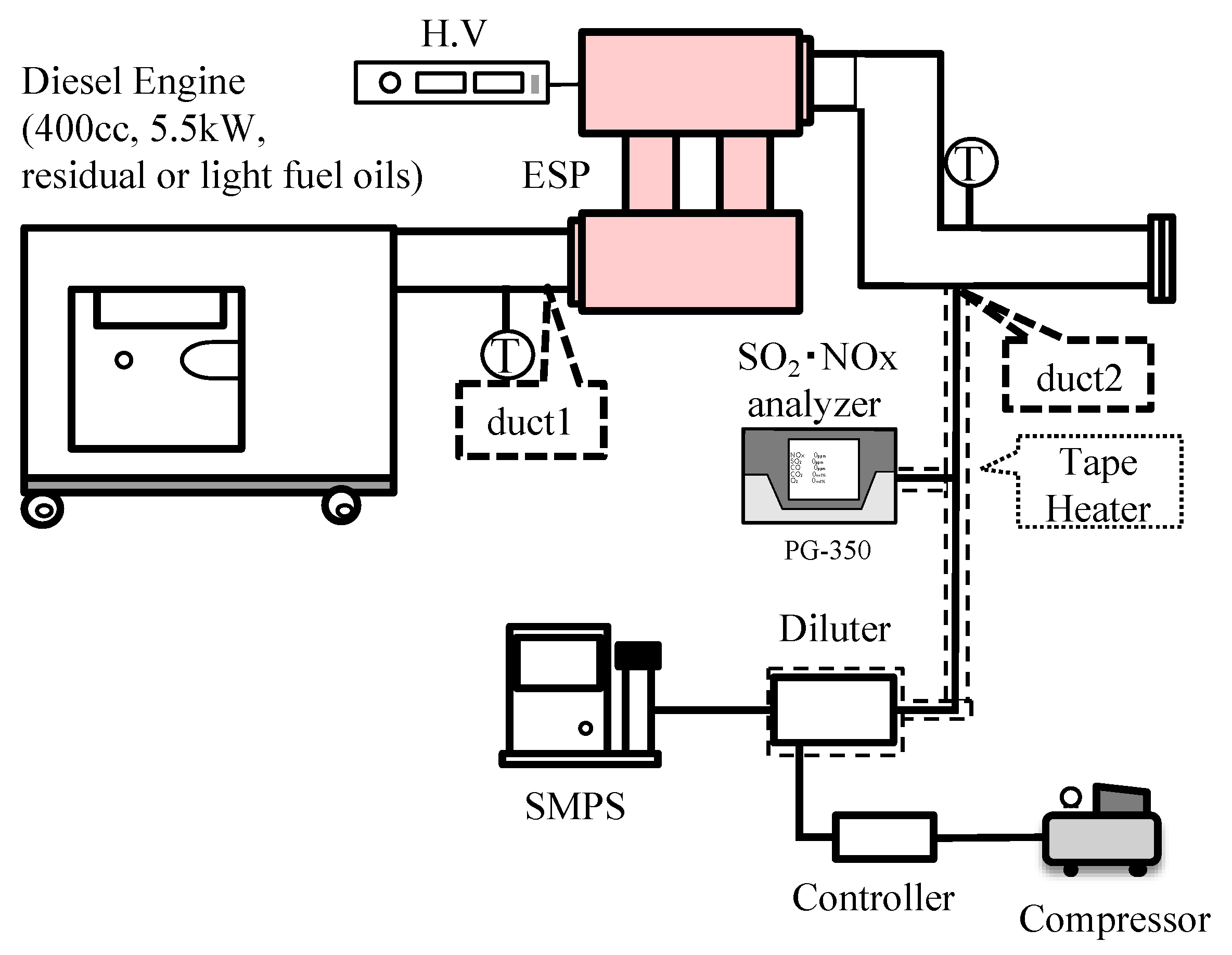
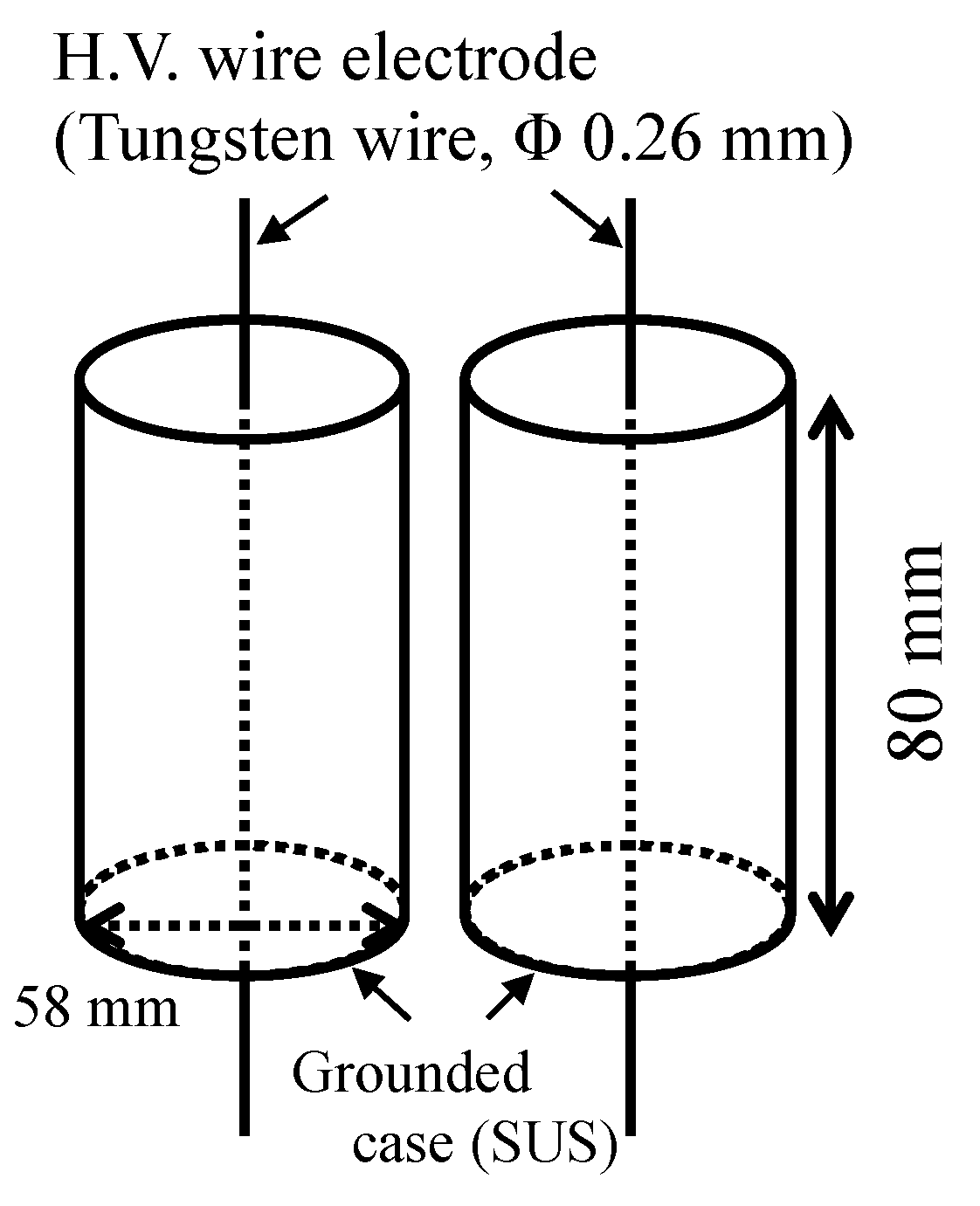
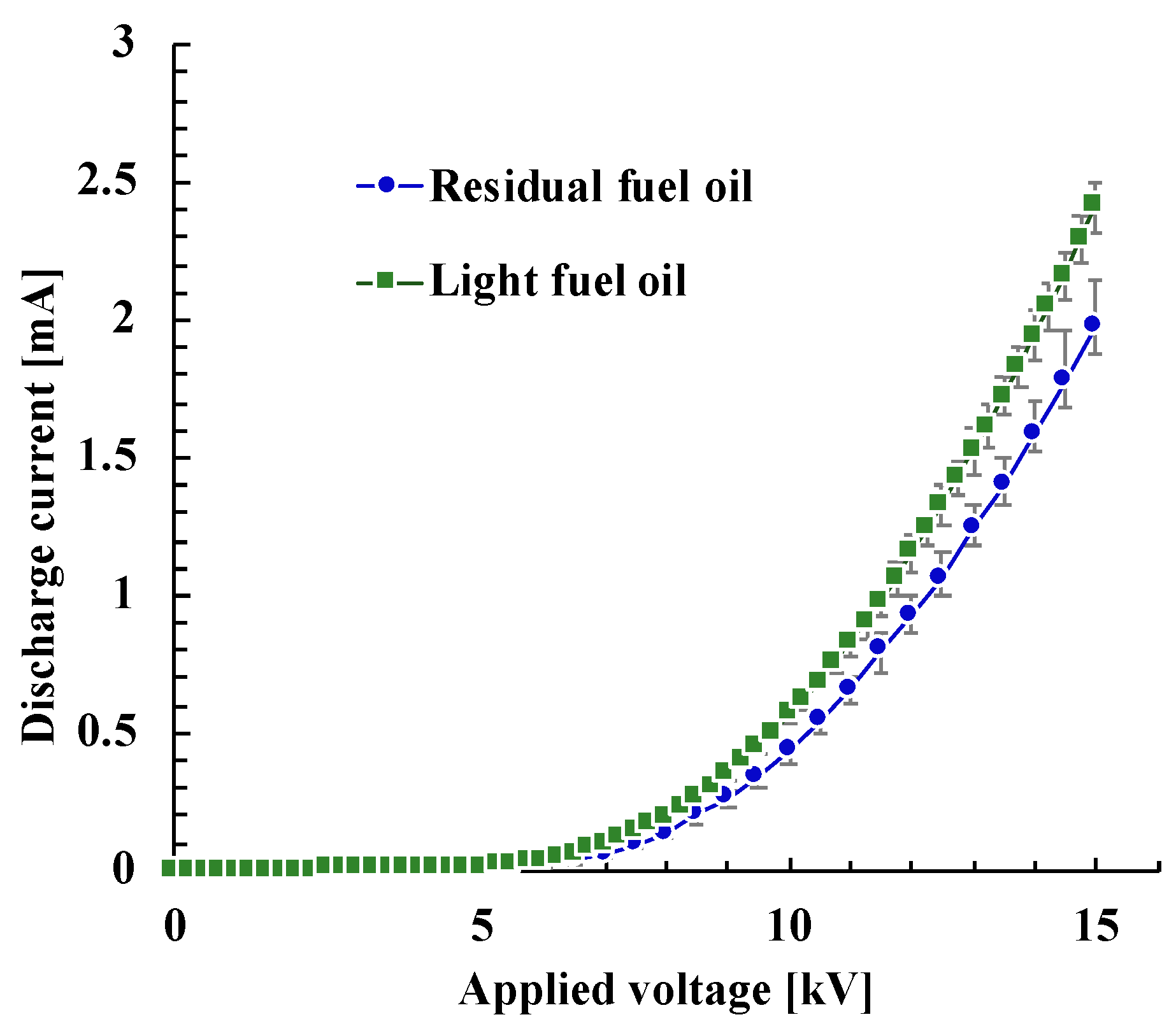
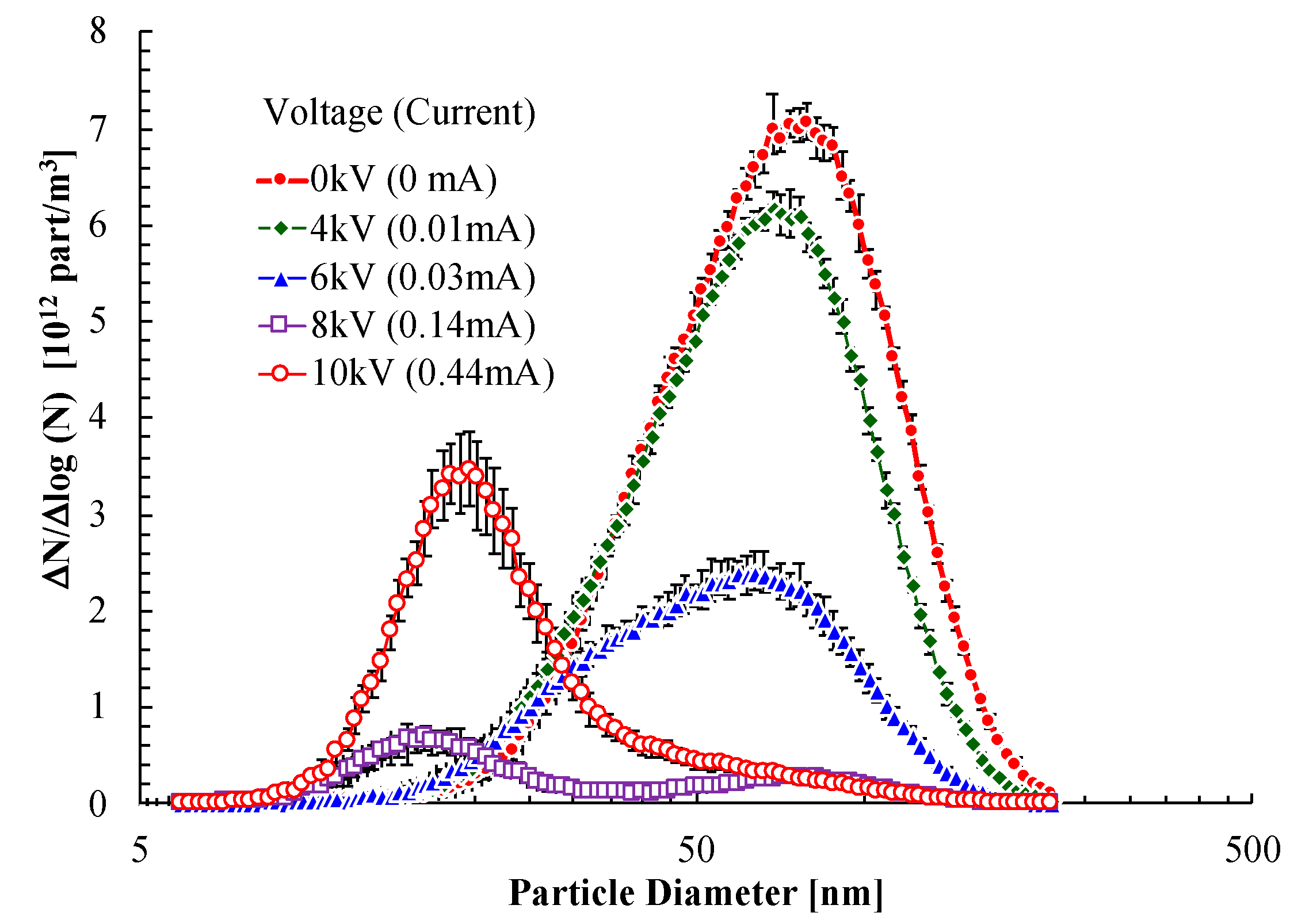
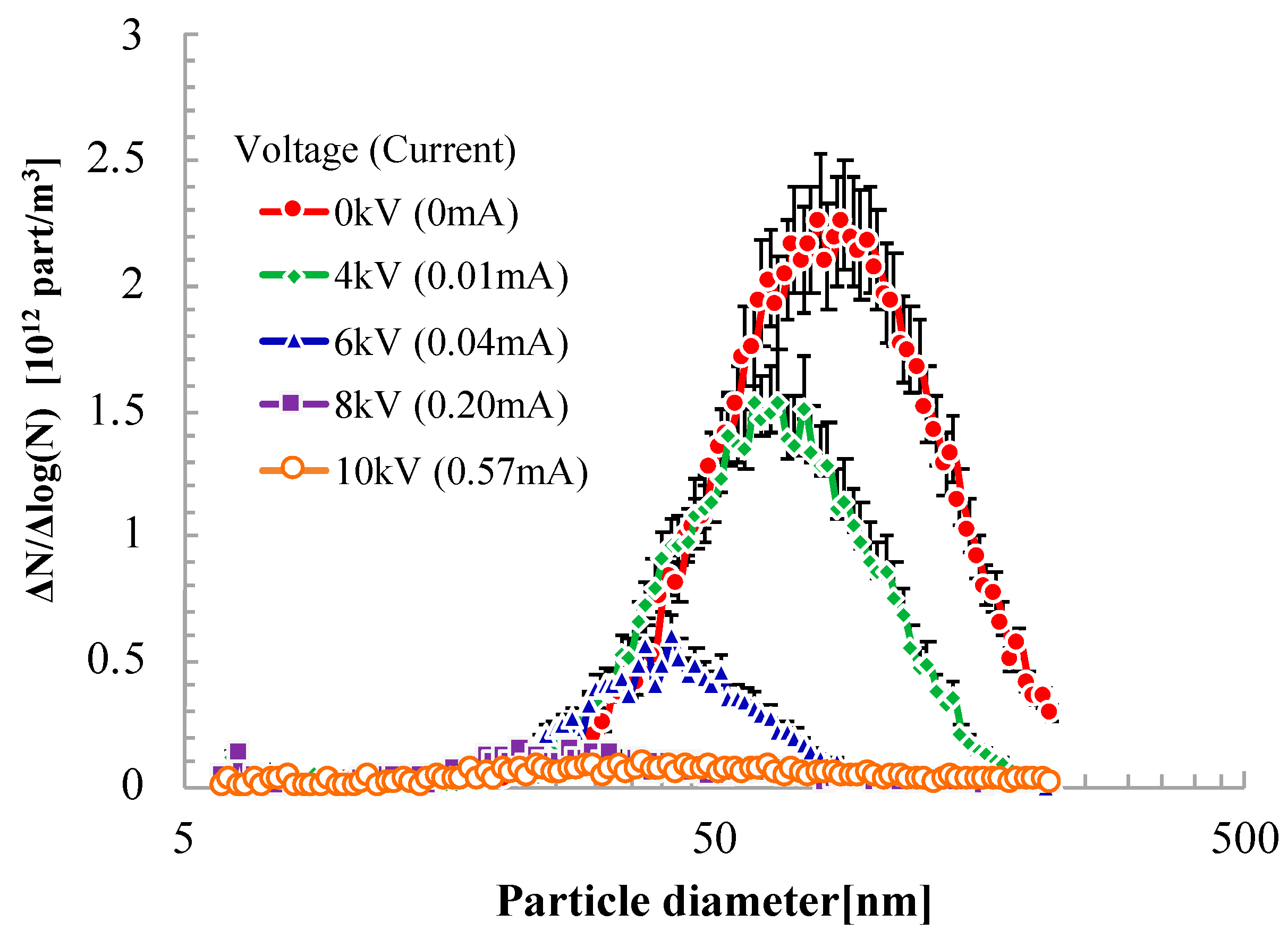
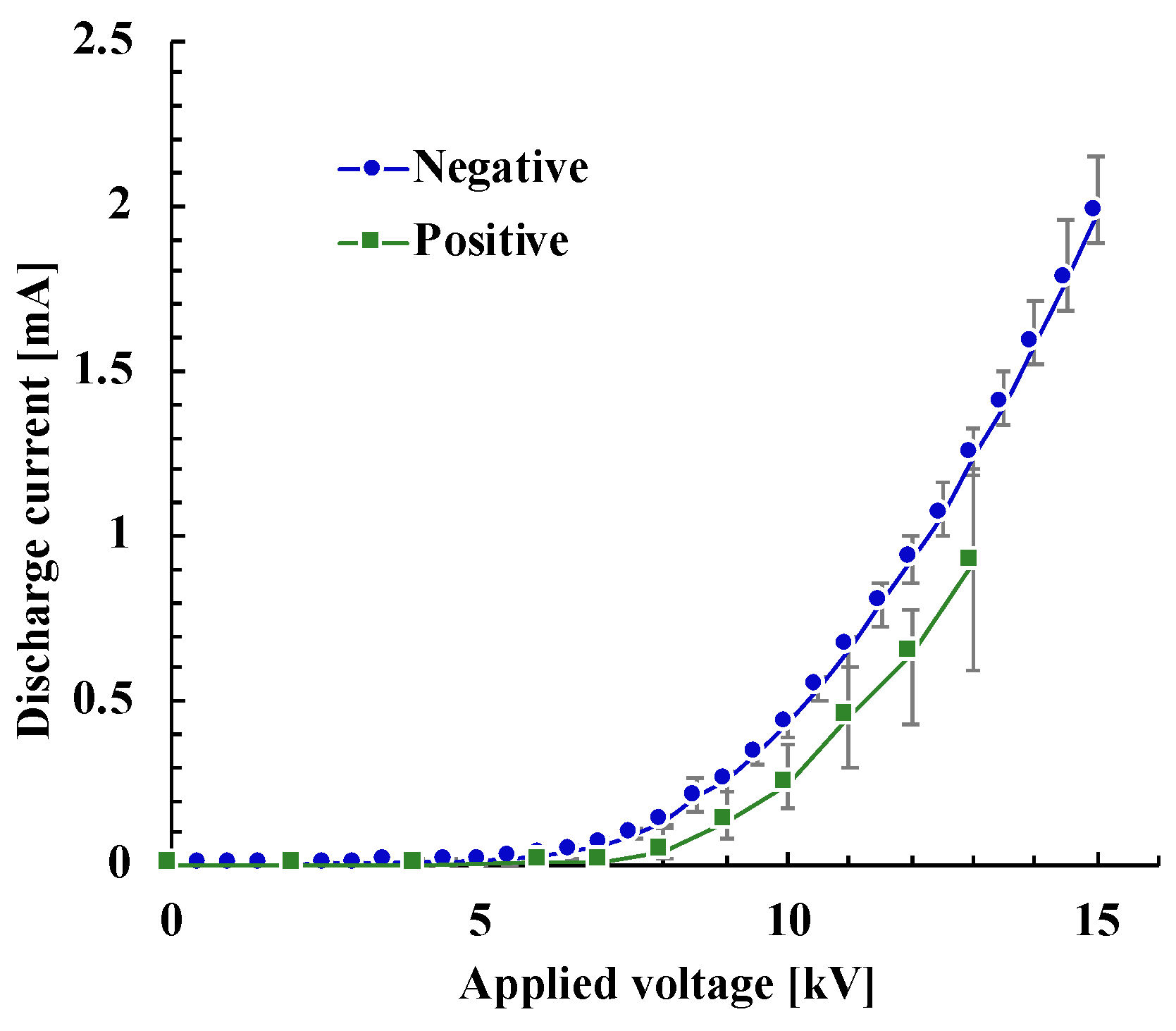
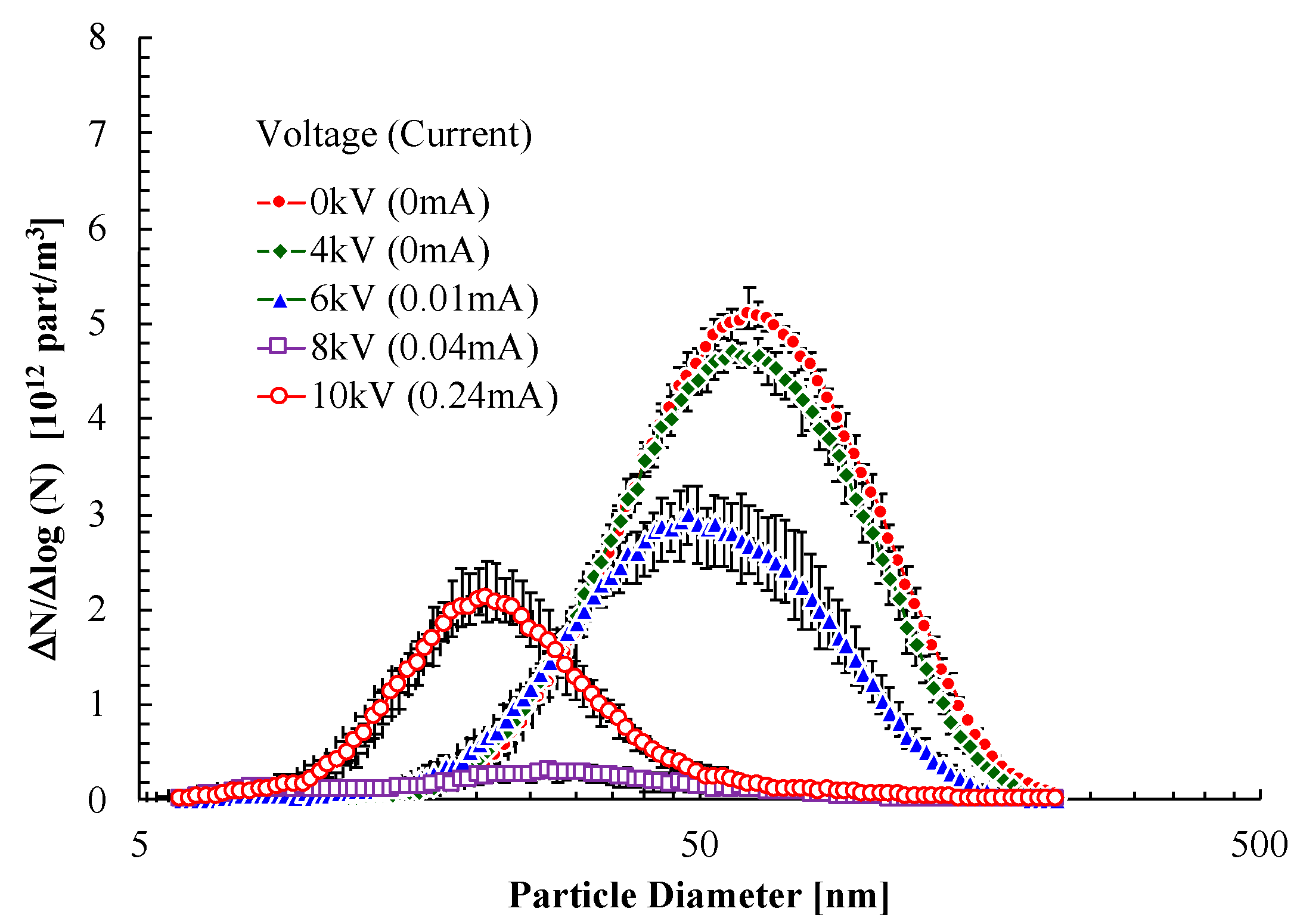
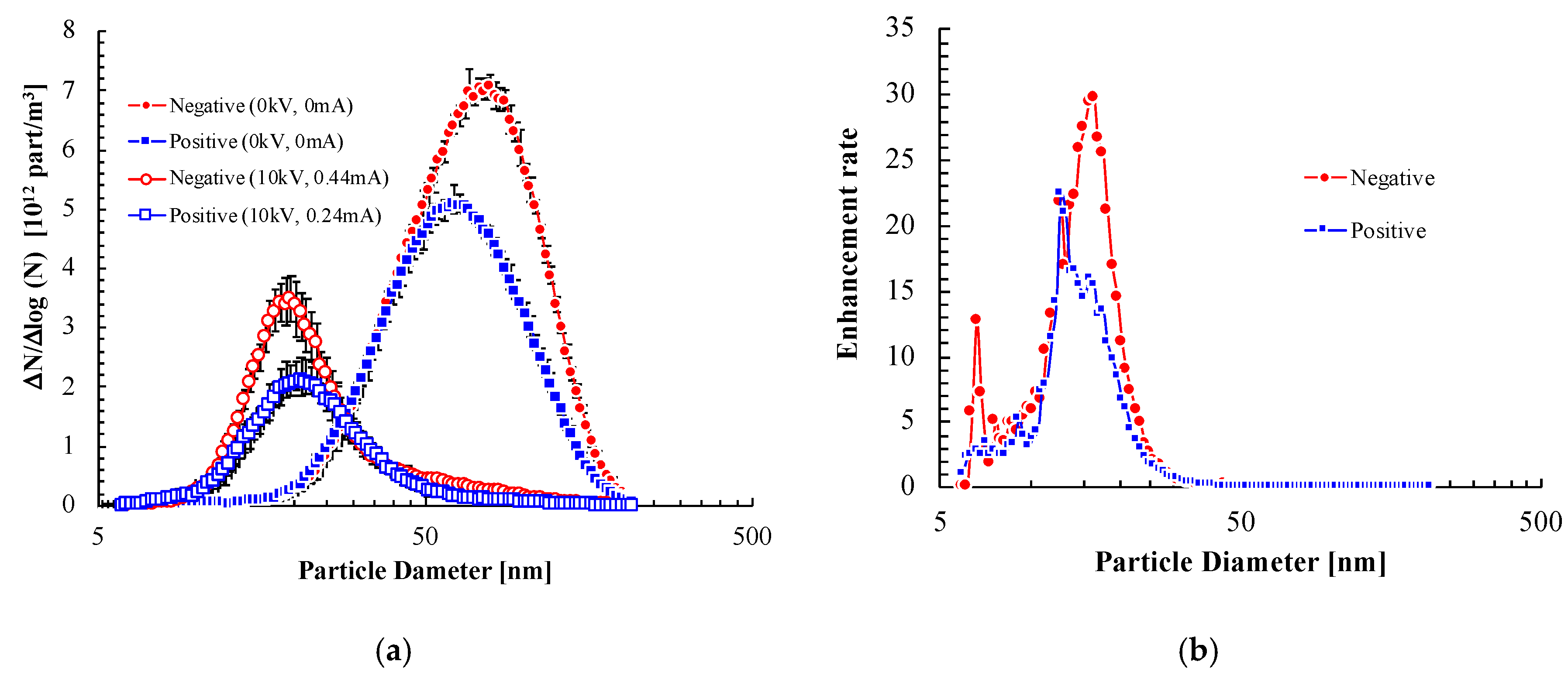
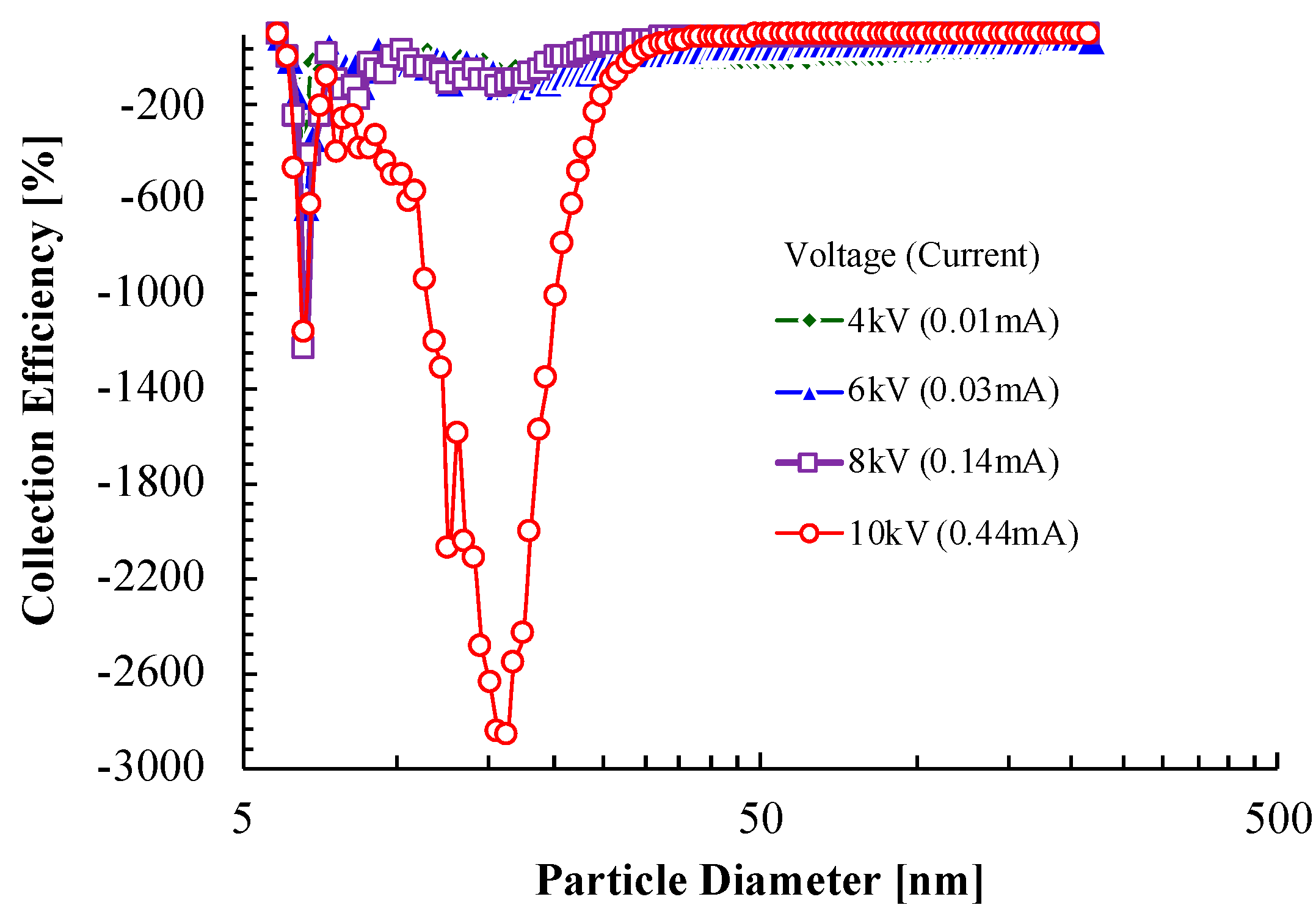
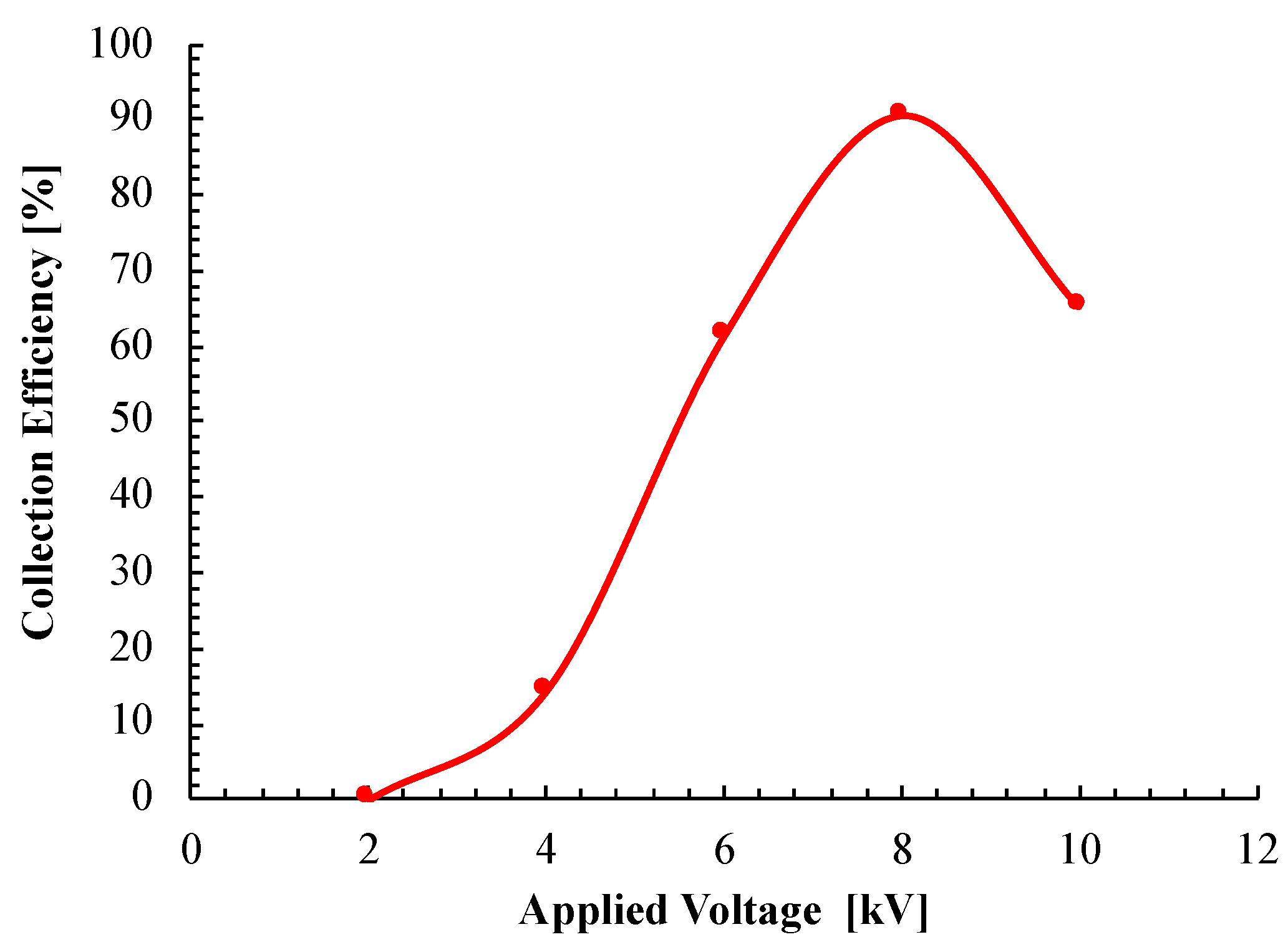
© 2019 by the authors. Licensee MDPI, Basel, Switzerland. This article is an open access article distributed under the terms and conditions of the Creative Commons Attribution (CC BY) license (http://creativecommons.org/licenses/by/4.0/).
Share and Cite
Zukeran, A.; Sawano, H.; Yasumoto, K. Collection Characteristic of Nanoparticles Emitted from a Diesel Engine with Residual Fuel Oil and Light Fuel Oil in an Electrostatic Precipitator. Energies 2019, 12, 3321. https://doi.org/10.3390/en12173321
Zukeran A, Sawano H, Yasumoto K. Collection Characteristic of Nanoparticles Emitted from a Diesel Engine with Residual Fuel Oil and Light Fuel Oil in an Electrostatic Precipitator. Energies. 2019; 12(17):3321. https://doi.org/10.3390/en12173321
Chicago/Turabian StyleZukeran, Akinori, Hidetoshi Sawano, and Koji Yasumoto. 2019. "Collection Characteristic of Nanoparticles Emitted from a Diesel Engine with Residual Fuel Oil and Light Fuel Oil in an Electrostatic Precipitator" Energies 12, no. 17: 3321. https://doi.org/10.3390/en12173321
APA StyleZukeran, A., Sawano, H., & Yasumoto, K. (2019). Collection Characteristic of Nanoparticles Emitted from a Diesel Engine with Residual Fuel Oil and Light Fuel Oil in an Electrostatic Precipitator. Energies, 12(17), 3321. https://doi.org/10.3390/en12173321




